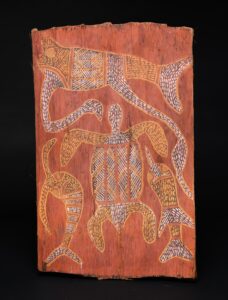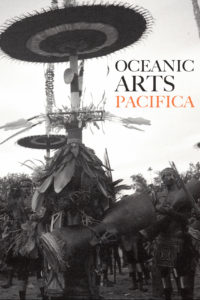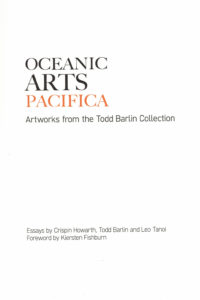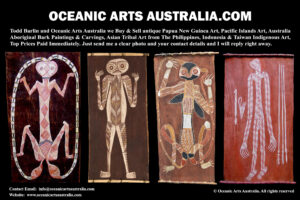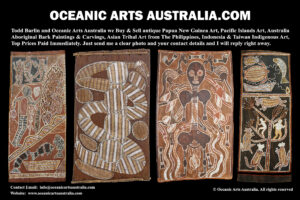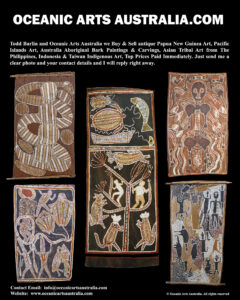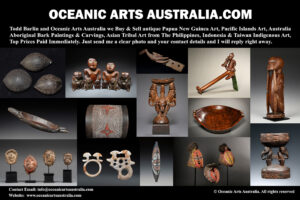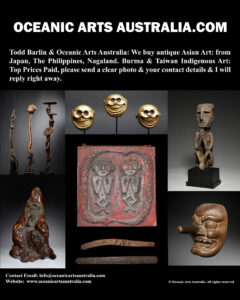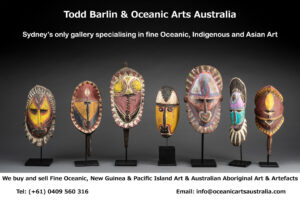A Superb Old Australian Aboriginal Bark Painting From Groote Island in the Northern Territory
| Collection No. | TB-4259 |
|---|---|
| Size | 50cm x 30.5cm |
A Superb Old Bark Painting of Totemic Sea Creatures from Groote Eyland Northern Territory Collected in 1960s (Artist Unrecorded )
This beautiful Bark Painting depicts various Sea Creatures, at the very top it looks like a shark with strange appendages.
Europeans collected the art from Groote Island almost as soon as they arrived. Groote Islanders painted and decorated the inside walls of their bark huts. Anthropologist Norman Tindale in 1921-1922 made the first collections of bark paintings. This collection is now in the collection of the South Australian Museum. Frederick Rose made another large collection in 1938, with the help of Fred Gray. Fred Gray encouraged local Groote Islanders to paint barks as a means of financial independence.
Charles Mountford collected his work in 1948 during the American Australian Scientific Expedition. In the 1950s, the Rev. L.M. Howell commissioned eight sets of narrative paintings from Thomas Nanjiwarra.
Later, Helen Groger-Wurm collected Nandjiwarra’s barks and these became the National Gallery of Australia’s first major acquisition of Aboriginal art in 1972.
In the 1960s and 70s, this distinctive and celebrated style reached a peak. It ceased with the advent of manganese mining operations which brought a disruptive influence to the island.
Groote Eylandt, in Anindilyakwa Country off the coast of northeast Arnhem Land, has been a center of bark painting since the 1920s. The heavy black background and dashed lines of red, white and yellow ochres that comprise this painting are characteristic of Anindilyakwa bark paintings from the middle of the twentieth century. The black pigment comes from the manganese that has been mined on Groote Eylandt for decades.
Chasm Island, off the northern coast of Groote Eylandt is known as the site of the first European documentation of Aboriginal rock art, one of the oldest continuously practiced artistic traditions in the world. It is likely that this painting refers to the mapping of this Country, or to ancestral stories relating to this area that link the landscape to early narratives of creation and the formation of geographical features.
The Groote Eylandt Mission was established at Emerald River in 1921. Its history is closely tied to the growth of the contemporary bark painting movement on the island. The first missionaries encouraged artists to produce portable barks that could be sold to provide income for the Mission. Artists began transferring the painted designs that previously decorated human bodies, rock shelters, and the inner walls of bark huts onto bark panels. Designs associated with secret or sacred knowledge remained restricted to certain artists and ceremonies.
This painting is in near-perfect condition, the family who owned had it packed away in a clean dry box for years, and the colour is as bright as the day it was painted due to their conservation of the painting never being kept in sunlight
Provenance: The Todd Barlin Collection of New Guinea Oceanic and Australian Aboriginal Art
See my new EXHIBITIONS GALLERY showing the Museums and Art Galleries Exhibitions that I provided artworks for over the past 40 years. There is the link to the article about my artworks published in the prestigious Louvre Magazine in 1996
I have artwork for Museums and art Galleries but also for collectors at every stage of their collecting. I want to encourage people to explore the fine art of New Guinea & West Papua and the Pacific Islands and to be able to see and touch the artworks in a relaxed and friendly manner in my Sydney Gallery. I would like to invite you to visit my gallery and see the artworks in person and also look at my website www.oceanicartsaustralia.com where there are many Galleries & Sub Galleries to explore.
My Gallery of nearly 40 years is the last physical gallery in Sydney that specializes in New Guinea and Oceanic Art. Sydney is very close to New Guinea & the Pacific Islands where all of these amazing artworks came from, Australia’s closest neighbors.
To see many more rare items and the finest masterpieces, please make an appointment with us to visit the gallery.
For all inquiries, please contact us

